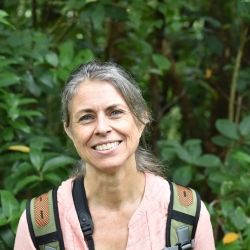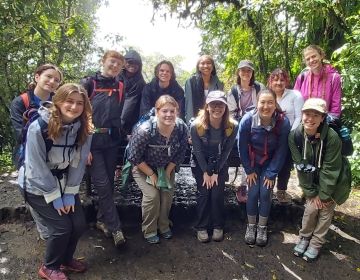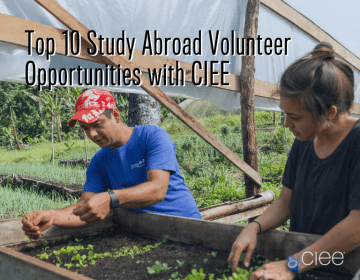Sustainability and the Environment: "We were in Nicaragua a while back..."
Hello old friends; it's been a while, hasn't it? That's because these adventurers have been out on a two-week field trip up and down the Caribbean coast, into Nicaragua, along the Panamanian border, and all sorts of crazy awesome places. They have learned, grown, changed, and learned some more on their long and winding journey. Here is their story:
Way back in mid-April, the adventurers boarded the Gravy Train (called this because the bus driver is named Gravy, not because it was a bus or train dunked in gravy or anything like that) and headed up toward the Nicaraguan border to see what this beautiful nearby country had to offer. All of the adventurers were pretty darn tootin' excited to be out and about again; they were getting a little restless there stuck in one place for almost a month.
Channy, Emma, Morgan, Amanda, and Meg all seem pretty stoked
They were super excited because they got to do the old bus-boat-boat, and there's just about nothing cooler than going up a river and across the invisible border into another country.
Erica is happy to be on a boat instead of having to swim into Nicaragua
Now a lot of the time on these long travel days, it's a good idea to try to take a nap or something. That's not the case with the boat ride into Nicaragua, because the boat ride itself is a super educational experience. It's also kind of a major bummer. All along the banks of the river, forest and wetland areas on the borders of sugarcane plantations were being burned. The burning of sugarcane is an accepted practice, because it makes the "cash-crop" portions of the product easier to harvest, but it's so dry in Nicaragua these days that a lot of the forests near the plantations are catching fire too and disappearing forever-- as are all of the unique and rare organisms that call these forests home. It's not a matter of Alfred Pennyworth and his friends trying to catch a jewel-thief-- it's a tragedy driven by greed, not metaphor.
It's not a cloud forest; its on fire.
Along the big river up to and into Nicaragua, the adventurers pulled the boat into the shallows and all got out to check out another upsetting development-- oil palm plantations. Oil palms are kind of a double-edged sword, because you've basically used palm oil in everything you've ever touched, but the creation of these plantations requires major deforestation of old-growth forest, forever altering the ecosystems and biodiversity. And not only are these plantations haunted by the ghosts of old-growth forest animals, they're also kind of dangerous. See, there's basically five thousand snakes in every oil palm plantation because there's ten thousand rats running around the place, because rats love oil palms and snakes love rats.
Amanda is on the lookout for drop-snakes; they wait until you look up at them... and then they drop on you (note to concerned parents: not really)
The photographer caught a rare glimpse of Bigfoot moving through the oil palm plantation in classic Bigfoot fashion
After carefully exploring around a little bit, the adventurers all gathered around to listen to a quick talk from Karen, Adam and Hector about the dangers these plantations pose to the conservation of wild forests, and the ethical problems of despising the process but supporting the product.
The great palm desert
The adventurers were growing to feel overwhelmed with the harsh realities they were confronting on the boat ride into Nicaragua, and all of a sudden they felt as though they wanted to wall themselves up somewhere to take shelter from the forces of destruction that were laying siege to the land from every side. So they journeyed up the river into El Castillo, the Nicaraguan town that was their destination. In El Castillo, they knew, they could take shelter in a great stone castle from three hundred and fifty years ago, a fortress built to protect the town from bloodthirsty pirates coming up from the Caribbean. With their eyes on that horizon, the adventurers stole away into the foothills of the castle.
The last stronghold against the pirates of the caribbean
Now the adventurers had come to El Castillo for a number of reasons, but one of the most important reasons was that this beautiful little town is adjacent to some of the last remaining primary forest in all of Nicaragua, called the Indio Maiz reserve, and the adventurers wanted to make sure they saw it before it disappeared. So early one morning, they went down to the river to jump into some boats and float on down to the reserve. When they got down to the water's edge, they made a surprising discovery; the river was at the lowest level it had ever been in the recollection of the El Castillo locals.
The skeleton of a cow peeks out from underneath the water.
On their boat ride into the reserve, the adventurers witnessed some more Nicaraguan nonsense happening, and that was the unabashed destruction of patches of secondary forest a stone's throw away from the reserve, most likely in the process of conversion to cattle land. This one was a major bummer, because the adventurers were able to turn their heads and witness the way that the great forests of the world will disappear.
When the adventurers made it into the reserve, they spent some time talking with a local guide who has been working to conserve the pieces of the forest that are left. She discussed a lot of the problems that the reserve is facing, and impediments to their conservation work. For instance, the reserve has enough money for boats to patrol the reserve and ensure its protection, but not enough money for gas. In every month, they might have about two weeks worth of gas, and that's it. Things like this make it kind of difficult to keep poachers and squatters out. Furthermore, she told them that the poachers who come into the reserve are not poor people; they are people with enough resources to avoid detection.
The guides are optimistic about the future, but they stress that a prosperous future for the Indio Maiz relies on the government, the people, and education. It is a delicate balance, and it is forest that is in very real danger of disappearing forever, so the adventurers were pretty stoked to get to go and walk around in it to see what all the fuss was about.
Adam's doing some teaching in his favorite kind of classroom
Now when they were preparing to come out here to Nicaragua, all the instructors made sure to remind the kids to bring their rubber boots and mud gear, because even in dry season, the Indio Maiz is consistently super wet and muddy. But if we ever needed more proof of climate change, this would be it; the usually deep and muddy trails of the reserve were hard-packed and crisp, and the forest was dry and sun-baked. I don't mean to imply that it wasn't a beautiful forest, because it definitely was, but the instructors were struck by how much it had changed in just a year. The times, they were indeed a-changin'.
Usually, Morgan would be in danger of getting swept into a fast-flowing river where she's at right now
On their lecture walk through the jungle, the adventurers spotted a little scarlet-webbed tree frog chilling out on a leaf. Actually, he wasn't really chilling out, it was more like he was baking. This little guy was super dehydrated, so Adam and the adventurers slid him into a nice baggie full of water to rehydrate him before they let him go.
Scarlett was having a rough morning
It was an experience full of emotions, and a little bit overwhelming, like most things are most of the time. The adventurers were looking forward to the days to come, when they would get to explore a little more of El Castillo and the forests and the homes around it. They made sure to soak in every minute of their adventure, because soon they would be on to another place, and this pirate town would be nothing but a ghost that haunted them.
Morgan and Sadia support the Indio Maiz, and they also support swimming
Related Posts
Happy Earth Day: Today and Every Day
Happy Earth Day! Every April 22, this global event comes around to remind us how precious our planet is, what sustainable efforts we can make to protect Earth, and that... keep reading
Top 10 Study Abroad Volunteer Opportunities with CIEE
Have you ever wondered if you could volunteer abroad? Perhaps you're looking into study abroad programs that provide international volunteer opportunities. If you’re itching to study abroad and truly make... keep reading
Recycling Internship with ADI San Luis
Written by Maya Peske (Cornell College), Internship in Sustainability and the Environment The road from San Luis up to Monteverde is well known by all of the people in the... keep reading



